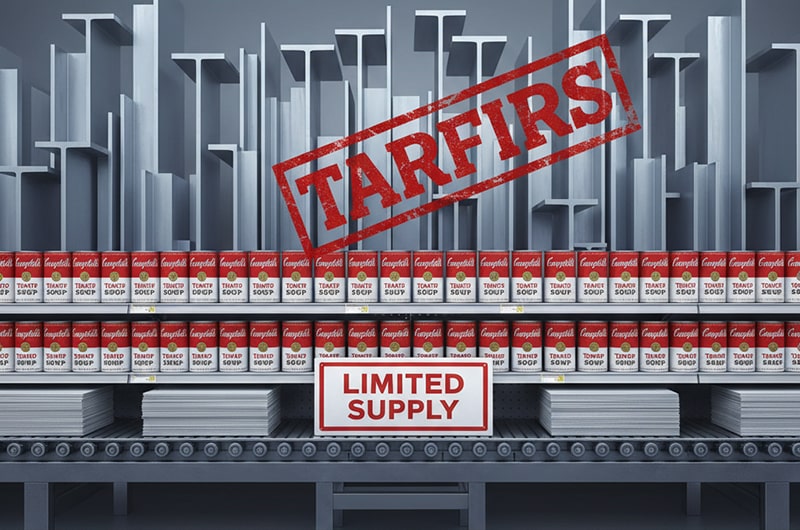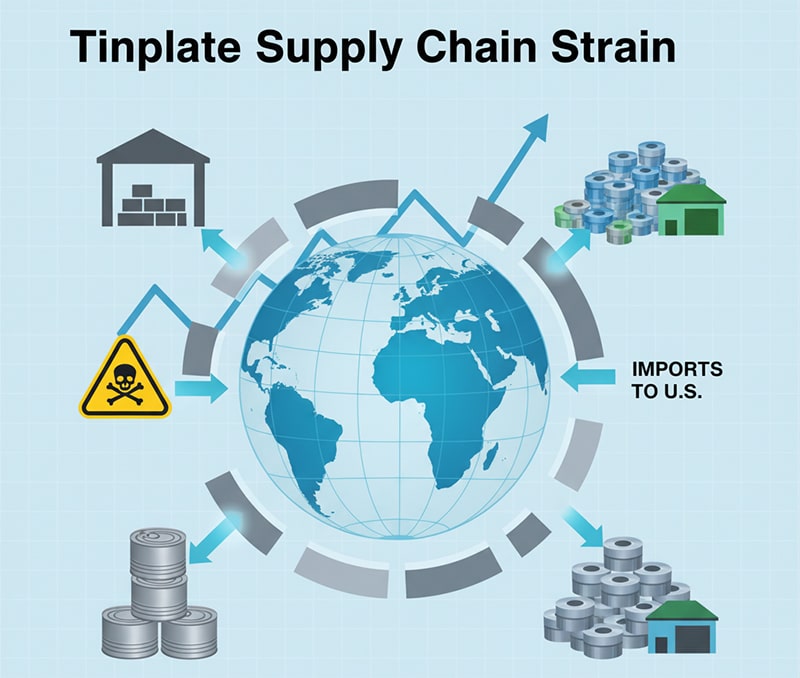
Facing persistent tariff burdens on steel and aluminum, Campbell’s expects only partial mitigation is possible. The company foresees that more than half of its duty exposure in fiscal 2026 is tied to Section 232 tariffs, and constrained domestic tinplate supply further limits its options.
Campbell’s plans to offset about 60% of its tariff burden for FY 2026, but still expects tariffs to account for ~4% of product cost.
Domestic tinplate capacity in the U.S. is insufficient, forcing reliance on imports.
While mitigation strategies (supplier collaboration, cost savings, price adjustments) help, they cannot fully shield the business.
For Campbell’s, the tinplate shortage is a critical bottleneck given its canned goods business.

During its September 3 earnings call, Campbell’s revealed that more than 50% of its projected tariff exposure stems from steel & aluminum duties under Section 232.
The company expects to absorb ~4% of its cost of goods sold due to tariff-related charges in FY 2026.
At the same time, Campbell’s anticipates it can mitigate approximately 60% of the tariff impact through various strategies.
According to CEO Mick Beekhuizen, the U.S. currently lacks sufficient tinplate manufacturing capacity to meet Campbell’s needs:
“There's not enough capacity available … If it was available, we would buy it locally. … we have no choice but to import that key raw material for our product.”
Because of that limitation, Campbell’s must rely on imported tinplate—even as it explores alternate sourcing options.
To blunt tariff pressure, Campbell’s is employing a mix of tactics:
Negotiating with suppliers for better terms or alternative sourcing
Cutting internal costs and improving operational efficiency
Selectively raising prices (“surgical price increases”) in key product lines
Leveraging co-manufacturers and international partnerships (e.g. working with Italian suppliers for sauce lines)
However, transition to new suppliers is not quick—Campbell’s stresses the need to retain product quality and consistency.
Below is a simplified table summarizing how Campbell’s estimates its tariff exposure and mitigation capacity:
| Metric | Value / Estimate | Context / Notes |
|---|---|---|
| Tariff share under Section 232 (steel & aluminum) | > 50% of total tariff exposure | Central component of tariff risk |
| Portion of cost of goods sold attributed to tariffs | ~4% | Indicates magnitude of tariff impact |
| Mitigation capacity | ~60% | Portion of tariff impact Campbell’s expects to absorb/reduce |
| Domestic tinplate supply | Insufficient | Limits local sourcing, forces imports |
Given the tight supply of tinplate in the U.S., Campbell’s is particularly exposed in its canned product segments (meals, soups, sauces). The company signaled that future price increases may be baked into its planning:
“We're limited to where we can source tinplate. … we do have to look at some surgical price increases, and so that's built into our plan as well.”
Even though Campbell’s has some flexibility—such as production in Georgia or co-manufacturer partnerships abroad—the limited domestic supply remains a hard constraint.

From the vantage point of tinplate packaging manufacturers and converters, Campbell’s revelations underscore critical structural dynamics in the tinplate ecosystem:
Capacity Scarcity as a Strategic Leverage
The fact that Campbell’s cannot procure sufficient domestic tinplate highlights that capacity constraints have become a form of strategic leverage. Tinplate mills with extra capacity can command premium margins or favorable contracts.
Supply Chain Resilience & Diversification Are Key
For manufacturers, the takeaway is clear: reliance on a single geography or supplier increases vulnerability. Expanding geographic reach, qualifying multiple suppliers (especially outside high-tariff zones), and investing in redundancy are prudent moves.
Upgrading Coating & Alloy Strategies
Given pressures on raw tinplate, manufacturers may shift toward more efficient coatings, lighter gauge construction, or tin-substitute alloys (while still satisfying food safety and printability). Those innovations can reduce raw demand per unit of pack.
Vertical Collaboration & Long-Term Contracts
Establishing long-term supply contracts with major end-users like food companies becomes more valuable. Co-development agreements, whereby the user helps finance upgrades or expansions in tinplate capacity or coating lines, might also grow in importance.
Pricing Power in a Tightly Balanced Market
As demand for high-quality tinplate in food packaging remains strong, especially for branded, printed cans, packaging suppliers may gain pricing leverage—particularly when buyers are squeezed by raw duty pressures.
While Campbell’s intends to partially offset tariff burdens through supplier strategies, cost savings, and modest price increases, the deeper constraint lies in the limited domestic tinplate supply. That structural scarcity reduces flexibility, making Campbell’s—and indeed many packaged food firms—more exposed to global tinplate dynamics.
For packaging and tinplate producers, the shifting landscape suggests opportunity: firms that can expand capacity, innovate in coatings or gauge reduction, and build strategic alliances with major food brands could capture outsized margins in the next wave of packaging consolidation.